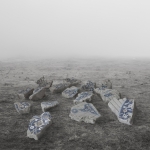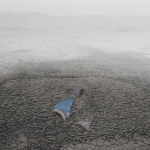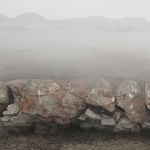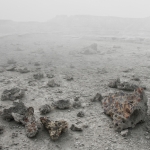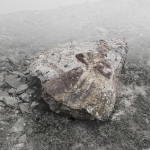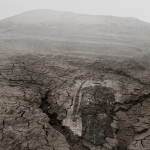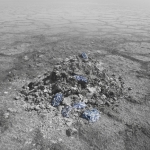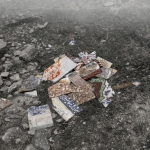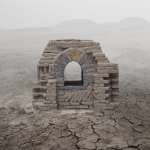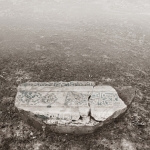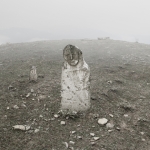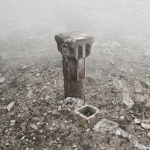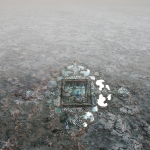Chapter Four(2013)
Verisimilitudes
Chapter Four:Found History (2013)
Statement of the catalogue:
The “found history” is closely associated with “found objects” (objet trouve), a rule which favors photographic act based on looking, finding and taking pictures. The same rules are at work in the present collection. Here the difference lies in that we observe this approach in the form of representamen not simulacrum.
The “found history” is not only closely associated with found objects but extends the structural rule of the latter to its subjects. The construct photographs included in this collection have been created by the juxtaposition of historical motifs and backgrounds seen and captured in various parts of this extensive land. Without the mediation of the photographer, these signs could not create the atmosphere which is displayed before our eyes here.
The “found history” is not the retrieved history. For the artist nostalgia and yearning for the past, a symbolic and metaphoric status accorded to these works, adopting a critical approach or any other possible interpretation are secondary and additional suppositions. The most favorable instance of communication is to engage the viewer in real moments and making him/her to experience the passion and amazement of what is going on in the images.
The fourth chapter of the Verisimilitudes Project has been titled the “found history” which is a non-historical dialogue with history, history as a persistent background of our today’s collective unconsciousness and what we unavoidably have to face, whether we opt to admire, leave, revive or even eliminate it!
I Run on a Blade between Reality and Surrealism
Mohammad Reza Shahrokhinejad interview with Mehdi Moghimnejad
You have delivered real elements to an imaginary world. All these elements do individually exist but the world represented in these photos lacks an objective reality.
These photos are constructions in the strict meaning of the word. I mean they are constructed photos. Although my experience in documentary photography enormously contributed to the creation of these photos, but the reality of the world did not satisfy me at all.
But historical memory warns us that a photo is definitely as same as a real thing.
Yes, it’s correct but these photos abuse the photographic historical memory and the documentary aspect of photos. As a matter of fact, the indexical aspect of photo has been abused numerous times. By using the word abuse I don’t mean a moral but an artistic abuse. There were many artists who played with this aspect in their works. These pictures impress the viewer because of their photographic aspect. They could have a different impression if they had been painted.
But a different impression from this one…
Yes, according to Chuck Close, the realities of paintings and photographs are not that much analogous. Although these photos were created in the medium of photography, they are constructed and make the illusion of reference to real things, an issue which extremely appeals to me.
We have observed such experiences in painting for example, in Diary of Destruction by Aydin Aqdashlou , but not in the medium of photography.
You are quite on the mark. I would say indeed that the hand-made image is intrinsically different from photographic image which creates some expectations. However, I would say that manipulation of photographs dates back to the early days of photography. So it’s not something new but instead the experiences of artists may be new. Perhaps it’s better to call these photos verisimilitudes and I have attempted to do my best to keep the final product photographic and not turn it into painting, graphic design or illustration. One can say that these photos are within the framework of digital images, but I have tried even in technical terms to return them to the world of photography.
Although this images are unrealistic but are not surrealistic as well…
Exactly…
While the paintings of Aqdashlou draw on real elements, such elements are represented in a way which become surrealistic.
For me the difficult task is running on the blade between realism and surrealism. But let’s see the issue from this view that in recent years drawing on historical elements in our contemporary art has turned into a genre. Regardless of using different mediums, the difference between these pictures with the works of Aqdashlou lies in different logics in employing these elements. In the works of Aqdashlou, they turned into symbols but it my photos they are tropes which draw on photographic logic. I have attempted to make the viewer perceive these photos as moments in reality.
In these constructed photos, you distort our historical memory of photography. You do exactly the same with motifs which you have already used, because the historical memory of Iranians turns these motifs into symbols.
Exactly! Each time I extend a principle in the history of photography to the subject I have selected. It means that the logic of this medium has extended to the subject of photos as well. We all know that reality of photography is not as same as the real world. Peirce refers to a very engaging point and says that realities are contested, and textual representations are thus sites of struggle. As our discussion is held in the framework of photography medium, we want to win acceptance for our views as painful experiences have been passed in the history of photography as well. We should also accept that during the last years, more progress has been made rather to directed photos than constructed photos.
Why?
Because photomontage works can easily turn into the works of entertainment. Examples are those photos which are uploaded in websites, which are constantly emailed and sometimes forged.
I suppose these types of photos must be whether extremely surrealistic or extremely realistic. If they are placed between these two realms they can easily turn into entertainment.
On the early days when I was working on this method, I had a technical obsession, but nowadays it has become a sort of worldwide view for me.
What was your stratagem for not to develop these motifs, metaphors or ironies into…
Satire…
Yes, satire and actually one of the figures of speech?
It was not that much intentional. Once a person is in the mood of satire, his writings develop into satire. Since I don’t observe my milieu like this, the works have not also approach such concepts. However, I agree that I dealt with a subject which is dangerous and during the last two decades has been a material for numerous works, which at times have pop artistic logic and sometimes are justified simply by the term, postmodern.
Aren’t they tragic?
Our discussion seems to become rather difficult! because they would have to explore the concept of tragedy. Don’t you think these are romantic?
I don’t think so. I really have no idea whether should be pleased with the collapse of this ancient civilization which has limited me, or be sad for my lost identity.
For me tragedy is an unavoidable destiny which people may do not deserve.
Have they deserved to experience such events?
I suppose it is related to the interpretative aspect of the works. These photos are the “found history”. The found history is not the retrieved history. I thought to myself that whether these motifs have recently come out of the soil or on the contrary are perishing. They look like the two sides of a coin.
But in these works the coin stands on its narrow edge.
Yes, but I don’t know whether these works represent the future of this land or its past…
But by using fog on surface, your photo has been more cleared up.
I did that to highlight the motifs.
Do you agree that compared with your earlier sets of works the iconic aspect of these photos are more highlighted?
Yes I do. In one of my earlier sets of works titled Cypresses I was going to create an imaginary paradise but the cypresses were exaggeratedly alone. As a matter of fact, the idea behind them was simply limited to them and no paradise could be created. But in my present set of works the photos are in a non-historical dialogue with history. I have always had a non-historical approach to history but at the end you will have a contemporary encounter with my works.
Why this collection was titled the found history?
Because it’s a history that I found. For taking these photos I embarked on a journey to the most remote places of of Iran for 10 years. I don’t have an admiring view to history but it cannot deny that these are a part of us and we cannot ignore the history. We can decide whether to admire history or not to like it, but we cannot exclude it. We are involved in history. This set of works is rather makes us encounter with history than suggesting an interpretation or anything else.
واقع نمایی ها
فصل چهارم: تاریخ یافت شده
تصاویر این فصل نیز شامل 13 عکس است که در سال 2011 ساخته شده و در ژانویه 2012 در گالری محسن در قالب نمایشگاه انفرادی ارائه شد. این عکس ها المان هایی از تاریخ ایران را در فضایی امروزی به تصویر می کشند. المان هایی که گویی تازه کشف شده و سر از خاک بیرون آورده اند. ما در این تصاویر با گذشته ی ایران مواجهیم. میراثی تاریخی که به گونه ای وهم آلود در پس زمینه های مه گرفته رهاشده است. شمایل های موجود درعکس ها بدون آنکه ارجاع دقیقی به دوره های مشخص تاریخی در ایران باشد درصدد بازسازی تصوری پنهانی از تاریخ و هویت ایران است که می تواند در ناخودآگاه جمعی ما وجود داشته باشد. از تندیس های ایران پیش از اسلام گرفته تا کاشی های مسجد کبود تبریز(ساخته شده در1465میلادی)؛ کوزه ای شکسته از سفالینه های نیشابور(قرن دهم میلادی-� Saljuk Dynasty)؛ نقاشی های اسطوره ای شاهنامه(قرن چهارم پس از اسلام-قرن دهم میلادی)؛ نقاشی مینیاتورها دوران پس از اسلام و شاهزاده ی قاجاری قرن نوزدهم.
استیتمنت کاتالوگ نمایشگاه
تاریخِ یافت شده با شیء یافت شده نسبتی نزدیک دارد. قاعده ای که عمل عکاسانه را استوار بر اصول دیدن، یافتن و گرفتن عکس می خواست. در این مجموعه نیز همین قوانین نقش آفرینی می کنند با این تفاوت که ما در اینجا نه درحد بازنموده بلکه در سطح وانموده با چنین رویکردی مواجهیم.
تاریخ یافت شده نه تنها با شیء یافت شده نسبتی نزدیک دارد بلکه قاعده ی ساختاری آن را به موضوعاتش نیز تعمیم می دهد. عکس های برساخته این مجموعه از هم نشینی نقش مایه های تاریخی و پسزمینه هایی بوجود آمده اند که عکاس در طی سال ها آنها را در گوشه و کنار این سرزمین پهناور دیده، یافته و به ثبت رسانده است. نشانه هایی که هر یک به تنهایی و بی مداخله ی عکاس نمی توانستند به خلق اتمسفری بیانجامند که اکنون پیش رو داریم.
تاریخ یافت شده تاریخ بازیافته نیست. نوستالژی و حسرت خواری نسبت به گذشته، قائل شدن به جایگاهی نمادین و استعاری برای این آثار، راه یافتن به رویکردی انتقادی یا هر احتمال تفسیری دیگر، همگی برای هنرمند گمانه های معنایی ثانویه و انضمامی به حساب می آیند. دلخواه ترین وضعیت ارتباطی، شریک کردن مخاطب در لحظاتی واقعی و مواجهه ی او با شور و شوق و شگفتی عکاسانه است از آنچه که دارد در صحنه رخ می دهد.چهارمین فصل پروژه واقع نمایی ها تاریخ یافت شده نام گرفته است. و این مکالمه ای غیر تاریخی با تاریخ است: تاریخ به مثابه پیشینه ای گسست ناپذیر از ناخودآگاه جمعی امروز ما. آنچه که به ناگزیر باید با آن رو در رو شویم. چه اگر بخواهیم آن را بستاییم، چه بخواهیم از آن روی گردانیم، چه آن را احیاء کنیم و یا حتی به حذف آن همت گماریم!
روي لبه تيغ راه ميروم
گفت و گوي محمدرضا شاهرخي نژاد با مهدي مقيم نژاد
عناصر واقعي اي را وارد جهاني تخيلي کرديد. تک تک اين عناصر وجود دارند اما جهاني که در اين عکسها ديده ميشود، واقعيت عيني ندارند.
اين عکسها به معناي دقيق کلمه کانستراکشن هستند يعني عکسهاي برساخته هستند گرچه که تجربهام در عکاسي مستند در به وجود آمدن اين عکسها خيلي کمک کرد اما انگار واقعيت جهان پيرامونم هرگز راضي ام نميکرد.
به هرحال خاطره تاريخي به ما گوشزد ميکند که عکس دقيقا خود واقعيت است…
بله درست است اما اين عکسها دارند سواستفاده ميکنند از اين خاطره تاريخي و وجه استنادي عکس. در واقع وجه نمايهاي عکس در جهان عکاسي بارها مورد سواستفاده قرار گرفته است منظورم از لغت سواستفاده، سواستفاده اخلاقي نيست بلکه سواستفادهي هنري ست. هنرمندان زيادي بودند که وجه را در کارهايشان به بازي گرفتند. اين تصاوير اگر بر مخاطب تاثير مي گذارد به دليل همين وجه عکاسانهشان است شايد نقاشي ميشدند تاثير ديگري ميگذاشتند.
ولي اين تاثير را نميگذاشتند.
بله. به قول چاک کلوز: “واقعيت در نقاشي و عکاسي خيلي قابل مقايسه نيستند”. اين عکسها برساخته هستند در حاليکه از مديوم عکاسي استفاده شده است و توهم ارجاع به وجود ميآورند، مسالهاي که برايم خيلي جذاب است.
تجربياتي از اين دست را در نفاشي و در “خاطرات انهدام” آيدين آغداشلو داشتهايم اما در مديوم عکاسي نه.
به نکته خوبي اشاره کردي. در واقع ميتوانم بگويم ذات تصوير دستنگار و تصوير فتوگرافيک با يکديگر متفاوت هستند که اين دو توقعاتي را ايجاد ميکنند. البته بايد بگويم دستکاري کردن در عکس قدمتي به اندازه سن عکاسي دارد بنابراين اين مساله چيز جديدي نيست اما تجربيات هنرمندان ميتواند تجربههايي نو باشد. شايد بهتر باشد اين عکسها را “واقع نمايي” بناميم و تمام سعي من اين بوده که نتيجه نهايي امر عکاسانه باقي بماند نه تبديل به نقاشي يا گرافيک يا تصويرسازي شود. ميتوان گفت اين عکسها درذيل تصاوير ديجيتالي قرار ميگيرند اما تمام سعي من بر اين بوده، حتي به لحاظ تکنيکي، که اين تصاوير دوباره به جهان عکاسي بازگردند.
گرچه اين تصاوير غيرواقعي هستند ولي سوررئاليستي نيستند…
دقيقا…
نقاشيهاي آغداشلو گرچه از عناصر واقعي بهره ميبرند اما همين عناصر در موقعيتهايي قرار ميگيرند که در نهايت فرا واقعي ميشوند.
سختترين وجه کار براي من راه رفتن روي لبهي تيغ رئاليسم و سوررئاليسم است اما بيا از اين منظر نگاه کنيم که استفاده کردن از المانهاي تاريخي در هنر معاصرمان در چند سال اخير، تبديل به يک ژانر شده است. تفاوت اين تصاوير با آثار آغداشلو جداي از تفاوت مديومهايشان، تفاوت در منطق به کارگيري اين عناصر است. اين عناصر در آثار آغداشلو تبديل به نماد مي شوند ولي اين عناصر در اين عکسها مجاز هستند و از منطق عکاسانه بهره ميبرند. تلاشم اين بوده که مخاطب اين عکسها را لحظهها در واقعيت حس کند.
در اين عکسهاي برساخته، شما به خاطرهي تاريخي ما از عکاسي خدشه وارد ميکنيد و دقيقا همين کار را با موتيفهايي ميکنيد که از آنها استفاده کردهايد چون خاطرهي تاريخي ايرانيها، اين موتيفها را تبديل به نماد مي کند.
دقيقا! من يک اصلي از تاريخ عکاسي را به موضوعي که انتخاب کردهام، تعميم مي دهم يعني منطق اين مديوم به موضوع عکسها هم کشيده شده است. همه ما ميدانيم واقعيت در عکاسي دنياي واقعي نيست. پيئس يک قرن قبل به نکتهاي اشاره ميکند که بسيار جذاب است و ميگويد:”واقعيتها در رقابت با يکديگرند و بازنماييهاي متني چيزي نيست جز عرصه رفابت اين واقعيتها.” تا زماني که بحث ما به مديوم عکاسي برميگردد ما ميخواهم واقعيت خودمان را به کرسي بنشانيم و تجربيات جانکاهي در تاريخ عکاسي رخ داده است. اين واقعيت را هم بپذيريم که عکسهاي کارگرداني شده در سالهاي اخير ترقي بيشتري داشته است تا عکسهاي برساخته.
چرا؟
چون فتومنتاژها ميتوانند به راحتي به سرگرمي مبدل شوند. نمونهاش عکسهايي که در سايتها ميبينيد و دايم ايميل ميشوند و گاهي جعل سند ميشود.
فکر ميکنم اين دسته از عکسها يا بايد خيلي فراواقعي باشند يا خيلي واقعگرايانه. اگر ميان اين دو قرار بگيرند به سرگرمي تبديل ميشوند.
روزهاي اوليه که به اين شيوه کار ميکردم يک نوعي وسوسه تکنيکي داشتم اما امروز برايم تبديل به نوعي جهانبيني شده است.
چه تمهيدي داشتيد که اين موتيفها، استعاره يا کنايه يا نماد يا…
طنز…
بله طنز و در واقع يکي از اين صنايع ادبي نشوند؟
خيلي خودآگاه نبوده است. يک آدمي روحيه طنز دارد وقتي هم مينويسد، نوشتهاش طنز ميشود. من چون اطرافم را اينگونه نگاه نميکنم، اين آثار هم نزديک اين مفاهيم نشده است البته قبول دارم به سراغ موضوعي رفتم که خطرناک است و در اين دو دهه اخير دستمايه کارهاي بيشماري شده است که بعضي اوقات منطق پاپ آرتي دارد، بعضي اوقات با لفظ پست مدرن توجيح ميشوند و غيره.
تراژيک نيستند؟
يک کمي بحثمان سخت ميشود! چرا که بايد واکاوي کنيم مفهوم تراژدي را. به نظرت اين کارها رومانتيک نيستند؟
به نظر من نيستند. واقعا نميدانم خوشحال باشم از فروپاشي اين تمدن کهنسال که جلوي دست و پايم را گرفته است يا غمگين باشم به خاطر هويت از دست رفتهام.
تراژدي براي من يک سرنوشت محتوم است که امکان دارد آدمها مستحق آن هم نباشند.
آيا اين چيزها حقشان بوده است که اين اتفاق برايشان رخ دهد؟
به نظرم به جنبه تفسيري آثار برميگردد. اين عکسها تاريخ يافت شده است. تاريخ يافت شده تاريخ بازيافته نيست. خيلي با خودم فکر کردم که آيا اين موتيفها تازه از دل خاک بيرون آمدهاند يا برعکس، دارند از بين ميروند. گويي دو طرف يک سکه هستند.
ولي اين سکه در اين آثار روي لبه باريکاش مانده است.
بله. ولي نميدانم اينها آينده اين سرزمين هستند يا گذشتهاش…
اما با گذاشتن مه نظرتان عيانتر ميشود.
مه را براي اين گذاشتم که موتيفها بهتر ديده شوند.
قبول داريد وجه شمايلي اين آثار نسبت به مجوعههاي قبليتان بارزتر است؟
بله موافقم. در مجموعهي سروها به دنبال ساختم يک بهشت خيالي بودم ولي به طور اغراق آميزي سروها تنها بودند و در واقع ايده کارها در خودشان تمام ميشد و بهشتي ساخته نميشد. اما در اين مجموعه، عکسها مکالمهاي غير تاريخي با تاريخ هستند. من هميشه رويکردي غير تاريخي به تاريخ داشتهام و شما در نهايت برخورد معاصري با آثار من خواهيد داشت.
و چرا اسم اين مجموعه “تاريخ يافته” است؟
چون تاريخي ست که من يافتم. براي ساختن اين عکسها به دورترين نقاط ايران سفر و عکاسي کردهام و به تدريج و در طي 10 سال شکل گرفته است. من تاريخ را ستايشگرانه نگاه نميکنم اما نميتوان کتمان کرد که اينها بخشي از ما هستند و نمي توانيم تاريخ را ناديده بگيريم، مي توانيم دوستش نداشته باشيم يا ستايش کنيم اما نميتوانيم پاکاش کنيم. ما با تاريخ سروکار داريم. اين مجموعه بيشتر مواجهي ما با تاريخ است نه تفسير يا هرچيز ديگري.
